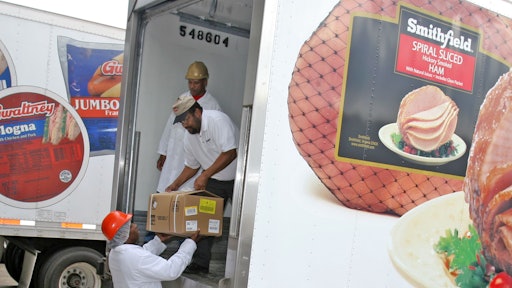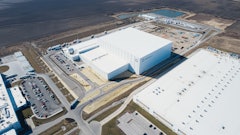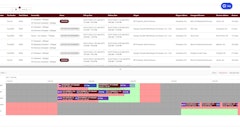
Accidents on the road and in the warehouse can cause serious bodily injuries—even death. The truth is that a significantly high percentage of accidents need never happen, as they are absolutely preventable. This section will examine accidents common in the trucking and warehouse arenas and how to prevent these costly accidents through common-sense and practical safety training programs and practices.
On The Road Again
Trucking companies take safety seriously. They are, ultimately, responsible for the safety of their drivers and of the public at large. Safety-mindedness begins the moment a truck driver clocks in, says Gary Petty, president and CEO of Arlington, VA-based National Private Truck Council (NPTC). “Safety on the road can even include a truck driver’s conduct when he is off his shift and in his private vehicle. If he is involved in an accident during these times, it could have serious implications for his continued employment with his employer.”
Causes: Even the most experienced driver is not immune to accidents. “Research has demonstrated that experienced drivers who are good at their jobs have two common flaws,” says George Mundell, executive vice president for NPTC. The first is overestimating distance from a vehicle in front of them, and the second is underestimating speed, either of which can lead to a catastrophic accident. “They get so good at operating their trucks that they sometimes push the envelope in these two areas, especially when they are on the same run every day which can lead to complacency.”
Lane changes have consistently ranked among the top reasons for truck accidents—either by the motorist or by the truck driver, reports Susan Chandler, executive director of the Safety Management Council for the American Trucking Association in Arlington, VA. “Studies conducted by the Federal Motor Carrier Safety Administration indicate that the majority of accidents are due to human factors such as everyday distractions or because one of the drivers is not fully focused,” she says. “For professional drivers, studies suggest that most accidents happen within a four-hour window after the driver has left the terminal. So we find that safety programs focus on developing a culture of safety, which includes teaching drivers to leave all other thoughts behind once they get behind the wheel and assume their role as professional drivers. This message is reinforced again and again in safety training programs.”
Driver inattention is another major cause of accidents, notes Mundell. “Simply reaching down to pick up a water bottle that fell to the floor can distract a driver.”
A driver’s health can also affect the potential for an accident. Research concludes that a driver’s body mass index (BMI) can lead to sleep apnea. “A driver with a BMI of 35 or greater is likely to suffer from sleep apnea,” Petty says. “If this condition is left untreated, he could experience micro bursts of sleep while driving which can lead to an accident.” Some companies have implemented voluntary sleep apnea mitigation programs for their drivers. “Although we haven’t yet reached a point to where we mandate that a driver has to be in this kind of program as a qualification for employment, it may come to this because of the seriousness of this condition.”
Prevention: Training, training, training is what companies must implement to prevent accidents, notes Dr. Tony Vercillo, president and CEO of International Fleet Management Consultants in Las Vegas. “Statistics show that 80 percent of all accidents are due to human error and they are preventable through proper training.” The cost of an accident is three to four times greater than the cost of fixing a truck involved in an accident because of the administration surrounding the accident report, the supervisor’s report, and getting the adjuster involved, he reports. “All of these things increase the cost, which many fleets underestimate because they focus on the fact that nobody got hurt.”
Companies should track accidents according to whether they are preventable or non-preventable, advises Vercillo. “Once companies track the cost per 100,000 miles for local drivers, and per million miles for long-haul drivers, they should do a causal analysis to determine the causes of accidents in order to begin to target specific areas requiring training or retraining. By targeting the areas causing 80 percent of accidents, companies can focus on teaching drivers through actual mock simulations, especially for accidents occurring at intersections and involving backing up.”
Simple and common-sense practices such as setting mirrors properly can prevent accidents. “You would be surprised to know how many drivers just don’t know how to do this,” Vercillo says. “Many fleet managers don’t do a good enough job in providing the correct type of mirrors such as installing West Coast mirrors and moon mirrors that extend a driver’s visibility, particularly behind the truck.”
A number of studies are continuing to evaluate safety technologies like stability control, collision avoidance systems, and lane departure alerts, notes Chandler. Part of that evaluation is considering whether these systems offer a significant return on investment in their ability to prevent accidents. Common-sense equipment maintenance such as checking tire pressure and making sure brakes are properly adjusted can help prevent accidents, adds Chandler.
Vercillo believes training is not happening enough in the industry. “You should train drivers at least once a year with formal training. I think companies should have a quarterly accident review committee that gathers several drivers, a supervisor, a safety and compliance person, and an HR person who can all review the company’s accidents over the last 90 days. They can then decide whether the accidents were preventable or not and make a formal decision on how the accidents could have been prevented and how to proceed going forward. This is really essential.”
What safety really comes down to is adopting the right attitude, notes Chandler. “With the launch of FMCSA’s CSA 2010 (Comprehensive Safety Analysis), the industry is focusing on developing a safety culture and ingraining in drivers an attitude change about making safety the first priority. This means driving defensively to try to anticipate what other drivers might do. It means slowing your speed, increasing your following distance, and developing a routine of constantly checking your mirrors.
“When changing lanes, don’t assume traffic will yield to you. Defensive driving really works and many training programs reinforce these attitudes and behaviors. For professional drivers, it is important to be calm and maintain control at all times when operating a truck.”
Warehouse Safety
Without proper training, workers in a warehouse environment could be prone to serious and even fatal accidents. New workers in this environment sometimes underestimate the numerous dangers imminent in innocuous-looking, slow-moving forklifts. The reality, however, is that forklifts carrying a load can weigh over twice the weight of an automobile and the results of being hit by one, or tipping over in one, can be disastrous. Forklift manufacturers and warehouse managers are developing comprehensive safety training programs that address how to prevent common accidents.
Causes: The most common accidents involve forklifts hitting things (including pedestrians), forklift tip-overs, and forklifts falling from docks. That is the bad news. The good news is that most of these accidents are preventable through proper operator training and through increasing safety awareness throughout all areas of the warehouse. “Since the OSHA training and compliance law went into effect in 1999, we have seen a dramatic reduction in incidence rates across the board, which demonstrates just how effective training is,” reports Ron Brewer, operator training manager for Crown Equipment in New Bremen, OH.
Forklifts hitting objects like ceiling support columns, racks, other equipment and pedestrians is the major cause of accidents, Brewer says. Tip-overs and off-dock falls are the next major causes. Operating industrial equipment like these forklifts can often mean an operator’s visibility is limited, reports Dixie Brock, national safety manager for APL Ltd, in Phoenix. “Sometimes drivers need to drive backwards and their bodies have to be twisted, impeding their ability to see the area immediately surrounding the forklift.”
Off-dock accidents happen when a forklift falls from a dock when an operator is loading a trailer, note industry experts. This can happen when companies don’t use wheel chocks placed behind tractor trailer tires when the trailer is backed up to the dock door. Wheel chocks prevent the trailer from separating from the dock floor, keeping the trailer in place as the forklift operator drives into the trailer with a load. If chocks are not used, the truck can separate from the dock, causing the forklift to fall to the ground, which can result in serious injuries or death to the operator (see Dock Safety on page 18).
Prevention: Brewer reports that the National Institute for Occupational Safety and Health (NIOSH) studied trained versus untrained operators prior to OSHA standard 29CFR 1910.178 for powered industrial trucks going into effect. “The study found that operator training reduced operator mistakes by as much as 44 percent. Beyond this, Crown has been focusing on proper training for supervisors as well to further reduce operator mistakes causing accidents. NIOSH found that when operators were trained and provided proper supervision, the result was a 70 percent reduction in operator mistakes, which equates to a near doubling of effectiveness.”
Although supervisor training is not mandatory, Brewer reports that Crown is trying to get the trend started because of the significant benefits in reducing accidents. “Since operator training was a big frontier and resulted in a big payback, we believe the next big frontier for the industry is supervisor training.”
According to OSHA, 1.5 million workers nationally operate 1 million powered industrial trucks. Annually, about 100 workers are killed using these trucks and about 95,000 are injured. The OSHA standard was designed to save at least 12 lives annually and to prevent about 10 percent of the accidents related to using these trucks.
Crown’s LeadSafe is a safety training program designed specifically for supervisors of industrial truck operators. “All too often, supervisors have had not forklift training and don’t know what the safe rules of operation are,” explains Brewer. “So this program trains supervisors on what safe forklift operation is and what to look for in unsafe practices. It helps train supervisors to be able to identify unsafe operator behaviors so they can encourage them to remember and practice the safety training they had been taught during their initial operator training course.”
When Brock writes training programs for APL, she makes sure the programs address three audiences: supervisors, operators and pedestrians. “Frontline managers are a critical element because they must understand what safe equipment driving looks like so they can make sure their operators are operating safely,” she says.
The dynamic between working forklift operators and pedestrians is critical. Pedestrians must respect the fact that operators often cannot see them because of visibility limitations while driving loaded forklifts.
“I am constantly reminding them not to do is to stand in the proximity of a forklift and always to be defensive around an equipment operator,” Brock says. “I tell them to make sure they always get the attention of an operator to make the operator aware that they are in the area. I encourage pedestrian workers to wear colored vests similar to what construction workers wear so they are more visible to forklift operators.”
Brock urges forklift operators to slow down around workers on the floor. “Even though some of these practices are not regulated, I teach that not paying attention to what is happening around you can result in serious injuries for yourself and for others.”
Although wheel chocking is such a critical task, sometimes people are unsure of who is actually responsible for chocking. OSHA says wheels have to be chocked when forklift operators are loading trailers—but it doesn’t say who is responsible to do this, say some in the industry. In order to clarify the responsibilities in this arena, companies might remind truck drivers when they turn in their paperwork to have their wheels chocked before loading can begin. It’s really a matter of establishing policy so people are clear about their responsibilities. Forklift operators should assure themselves that the wheels are, indeed, chocked before loading begins.
Brock says the dock area presents some of the most dangerous risks to workers, especially to equipment operators. “A trailer pulling away from a dock is the most critical risk facing operators because when this happens, operators can suffer serious injury or even death,” she says. Some APL warehouses do not have dock locks, so Brock implemented a company-wide practice called Glad-Hand and Cone policy.
“When the truck arrives, the equipment operator puts a glad-hand lock on the air hose which makes it difficult for a truck to pull away in error. The operator also places orange cones out in front of the truck to prevent the driver from accidentally pulling away while the operator is loading the trailer. This policy greatly reduces the risks and has been very effective for us,” she says.
Brock also endorses what she calls a three-point hold when getting into or out of a forklift. “This means you have two hands and one foot—or two feet and one hand—always attached to that forklift at all times until you have both of your feet safely on the ground,” she says.
Another area of focus is training forklift operators what to do in the event of a tip-over or off-dock accident. Experts suggest that operators running sit-down counterbalanced trucks stay with their truck if there is an off-dock incident. Operators should always wear seat-belts with both hands on the steering wheel as they ride the fall. If they try to jump off, they are at risk of having an 8,000-pound truck fall on top of them. Operators using a stand-up truck are advised to step off the back of the truck in the event of an accident.
Speeding on a forklift is not tolerated in the warehouse. “We train our operators to understand the relationship between the speed and stopping distance of their lift trucks,” reports Brewer. “For instance, if you are driving around blind spots or in congested areas, halving your speed will not only reduce your stopping distance by 75 percent, but it will also reduce the energy of an impact. If you double your speed, your stopping distance will increase by four times. So speed has a dramatic effect on your ability to stop your truck.”
Other Considerations
What about maintaining safety practices in refrigerated and frozen environments?
“The biggest thing you could do in these icy environments is to slow way down on your industrial equipment,” reports Brewer. “Some companies use siped tires to improve wet floor traction. They have fine razor-thin slits that help squeegee away the water, allowing it to escape so you can get better traction. In freezers, companies use tires made of a soft polyurethane compound that allows tires to compress against the floor, giving you more surface area on an icy floor.”
Although many companies use incentives to motivate their employees to work safely, industry experts note it’s not about the money. “Drivers like to be valued and recognized for their safety endeavors,” notes Chandler at ATA. “We have consistently shown that although money can be recognition of worth, it hasn’t been shown to have a dramatic impact on safety—which is really all about having the proper attitude toward your work and about recognition among your peers.”




























